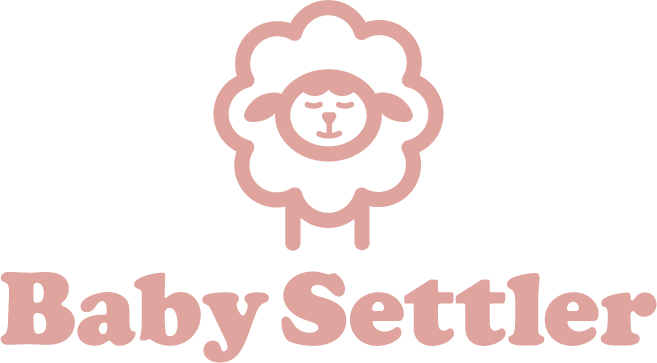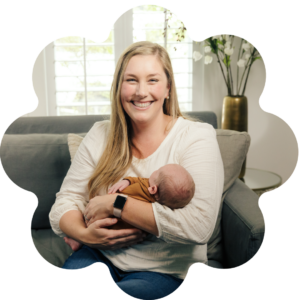Not every parent gets the information about newborn sleep that they need when they’re pregnant. So, they bring home their baby not knowing how to support longer nighttime sleep. This is where baby sleep training methods come in.
Not everyone’s going to have to sleep train. Yes, you can avoid sleep training! At Baby Settler, our whole mission is built on setting you up to have your baby naturally extend their nighttime sleep without having to sleep train.
So, if you’re reading this and you’re still pregnant, I highly recommend that you add two more things to your infant parenting classes: Read our book Babies Made Simple: The Modern Mom’s Roadmap to Navigating the Overwhelming Baby Stage, and take one of our baby sleep courses, Babies Made Simple. We outline from day one what you can do to set your baby up to naturally extend their nighttime sleep without sleep training. This looks like getting efficient, effective feeds; managing wake windows to prevent over-stimulation; and then setting your baby up to increase their nighttime sleep using a routine.
For the parents who didn’t get this information during newborn classes, what are your options? Getting to the point where your baby isn’t sleeping can be incredibly frustrating and exhausting. We know that quality sleep is vital for the family, for mom’s mental health, as well as the baby.

What Is The Best Age To Sleep Train A Baby?
As stated above, you can lay the foundation for good sleep habits when you bring your little one home.
If this is not the case, you can begin sleep training methods at around four to six months old. This is when your baby is more likely to be able to self-soothe and their circadian method is more developed.
Today’s Parent also points out that it’s around this age, “…when your baby hasn’t had much time to get used to nursing or rocking to sleep.”
Of course, every baby is different, as Healthline tells, “Premature babies, as well as infants with special needs or weight gain or feeding challenges, require special consideration when it comes to their readiness and a particular sleep training method’s appropriateness.”
Let’s explore some sleep training options if you’re struggling to get your baby to sleep for longer periods:

Cry It Out Method
Also known as the extinction method, this is the most severe method of sleep training. I personally do not recommend it. I’m not judging a parent who chooses this, but I would say that it is pretty intense. I would definitely not recommend it before a baby is four to five months. And, if you are choosing this approach, you should first ensure that feeding is not behind your baby’s sleep struggles. When you reduce nighttime feeds, it’s important to ensure that your baby is still getting adequate calories during the day. “It’s a good idea to come up with a night weaning plan in consultation with your child’s pediatrician or healthcare provider…One sign that your child may be ready may be that they are naturally stretching out feedings at night, but still gaining weight well,” suggests Verywell Family.
For this form of sleep training, you put your baby in their sleep space, and you tell them good night and that you’ll see them in the morning. Then, they basically cry until they fall asleep. There’s no soothing or anything; you’re just kind of ripping the band-aid off and letting your baby figure it out.
“The point of all sleep training methods isn’t to keep a baby from waking up during the night (everyone does, even adults), nor is the goal for baby to get through the entire night without a feeding (breastfed infants might continue needing a feed up to age 1). The goal is simply to teach baby to fall asleep on her own, outside of your arms,” adds What To Expect.

Gentle Sleep Training Method
This is also called the no tears approach. Anytime your baby cries, you’re responsible for soothing them. I would argue that this method prolongs the sleep training process because you’re still your baby’s self-soothing anchor. So, you’re not allowing your baby to have any space to learn how to self-soothe.
Cleveland Clinic points out that this approach is typically easier for parents as you’re still responding to your baby. You’re still a physical comfort to your little one. They suggest, “…be sure you don’t linger when you pick them up. Go in, pick them up, sooth them so they settle down, put them back in the crib, then leave the room.”
If you choose this method, just know that you’re in it for the long haul. Your baby could be a toddler before they’re sleeping through the night. You have to look at the pros versus cons, including your family unit, mental health, and your unique baby.
Chair Sleep Training Method
With the gradual withdrawal method, you’re visible to your baby as they are putting themselves to sleep. Essentially you’re moving farther and farther away from their sleep space as the nights go on. The hope is that they begin to put themselves to sleep without having you be right next to them. You help baby sleep by letting them know you’re still there.
“For instance, on nights one to three, you might have your chair right next to the crib, holding your baby’s hand or patting their back. Then, on night four, you might scoot your chair a little bit away and stop the hand-holding,” explains Parents.

Ferber Sleep Training Method
This method has been highly successful with the majority of babies that I have worked with. In this method, you, “…put baby down to sleep even if he’s crying, then return to check on him at different time intervals – every five, 10 and 15 minutes, and so on. You don’t pick baby up during these checks but can verbally soothe or pat him. Gradually, the intervals will get longer until eventually baby is sleeping through the night,” explains The Bump.
Inside our new parent guide, Babies Made Simple, we highlight multiple tips to help baby sleep. This includes what we call the modified delay method, the wean feeds method, and the delay method. This kind of maps out your strategy to utilizing a type of Ferber method successfully.
If you have started doing things like co-sleeping, nursing or giving a bottle to sleep, your baby has been sleeping in a Dock-A-Tot or a SNOO, or they have had some external sleep props that have helped them get to sleep and they’re older than four months old, then you do have to use a sleep training method to help your baby learn how to self soothe.

In the case of a baby older than four months old and you are looking for a strategy to help you get that extended nighttime sleep in conjunction with something like the Ferber method, you need to have a detailed strategy of how you’re going to use that.
Looking at the holistic picture, and that includes feeding, will help you get your baby to extend their nighttime sleep.
No matter what sleep training method you land on, establish a bedtime routine. “A bedtime routine creates a smooth transition between night and day. Follow the same steps in the same order every night to help your baby understand that it’s time to sleep,” advises WebMD.
Also, it’s important to realize that even once sleep trained, a baby can have difficulty sleeping as they reach developmental milestones. “Be prepared to change routines as your baby grows and enters different stages. And remember, growth spurts, teething and illnesses can all affect how your baby sleeps,” says the NHS. Be realistic about what you can expect from your little one.
There are a ton of experts and influencers who are trying to help you with baby sleep. But, at the end of the day, you need to choose what is best for you and your family. I would argue that you can bypass all of this if you just start early on by taking online new parent classes and pregnancy courses. So if you’re seeing this during pregnancy, don’t delay. Learn about the connection between sleep and feeding early on so you don’t even need the above methods.
However, if you’ve brought your baby home and the prenatal courses you took don’t seem to relate to your experience, it may be time to chat with a baby sleep consultant. All Baby Settler providers are highly qualified to help you find success.




